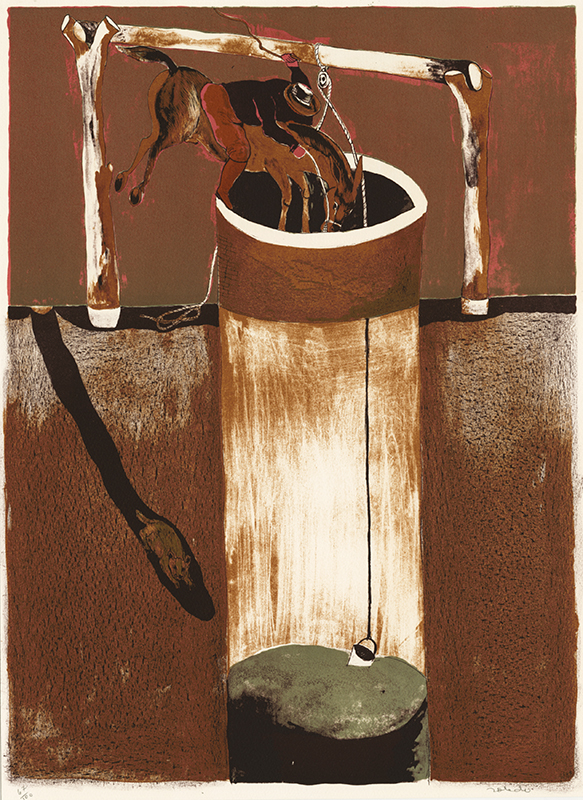The Well is a color lithograph from 1971 by Mexican printmaker Francisco Toledo. This impression is pencil signed and editioned 67/100. It was printed on a heavy, ivory wove paper by Clot, Bramsen et Georges, Paris, and was published by the Ferdinand Roten Galleries, Inc. The image measures 20-1/2 x 15-3/4 inches. There was also a preferred edition of 75, printed without a border.
Francisco Toledo created a series of color lithographs in 1971 featuring images of Mexican vaqueros or cowboys. His imagery retained his exploration of the fantastical, images that read like tales open to interpretation by the viewer. In The Well, a vaquero seems to purposely plunge himself and his steed down a well, as a burrowing mole tunnels its way diagonally toward the same destination or fate. The practice of herding cattle on horseback was brought to Mexico by the Spanish in the 16th and 17th centuries and spread from Mexico to the United States in the 18th and 19th centuries. The almost mystical connection between cowboys and their horses appealed to Toledo’s interest in hybrid creatures and connections between the natural and supernatural worlds.
Francisco Benjamin López Toledo, renowned painter, sculptor, printmaker, activist, and philanthropist, was born in Juchitán de Zaragoza, Oaxaca, Mexico on 17 July 1940 to Francisco López Orozco and Florencia Toledo Nolasco. He studied at the Escuela de Bellas Artes de Oaxaca and the Centro Superior de Artes Aplicadas del Instituto Nacional de Bellas Artes in Mexico City, where he studied printmaking with Guillermo Silva Santamaria.
Toledo had his first solo exhibition at the age of 19 years old in 1959 in Fort Worth, Texas. The following year he left for France to study and, while there, met Rufino Tamayo and Octavio Paz. He remained in Paris for five years and during that span of years he worked at Stanley William Hayter’s Atelier 17 workshop. He returned to Mexico in 1965 and then moved to New York briefly in the late 1970s. Toledo established his home in Oaxaca in 1980. That same year a retrospective of his work opened at the Museo del Palacio de Bellas Artes in Mexico City and, in 1984, a retrospective of his work was mounted at the Mexican Fine Arts Center Museum in Chicago.
It was stated, “With his leadership…and sophistication he put the eyes of the world on a small state like Oaxaca, putting it on the map as an epicenter of art and resistance.” In 1998 Francisco Toledo collaborated with the Papel Arte Finlandia to found the Taller Arte Papel Oaxaca; a workshop and creative space for the community of San Agustin Etla, Oaxaca that was housed in an old federal building that the artist purchased and later donated to the municipality. Toledo’s aim was to revive interest in cultural traditions and provide employment through handmade paper and paper crafts, using only local natural fibers and mineral dyes. It soon became the catalyst for the reforestation of the Oaxacan land. Toledo founded the Instituto de Artes Gráficas de Oaxaca as well as a cultural center in Juchitán and helped establish the Oaxaca Museum of Contemporary Art. In 2005, Toledo won the Right Livelihood Award—Sweden’s alternative Nobel prize for “devoting himself and his art to the protection and enhancement of the heritage, environment and community life of his native Oaxaca.”
After the disappearance of forty-three teaching students in Guerrero in 2014, Toledo made forty-three kites, each featuring the face of one of the missing young men. As the kites were flown in central Oaxaca city, he said that the search for the students mustn’t ever stop–“we must also look for them in the air.”
Francisco Benjamin López Toledo died on 5 September 2019 at the age of 79.



